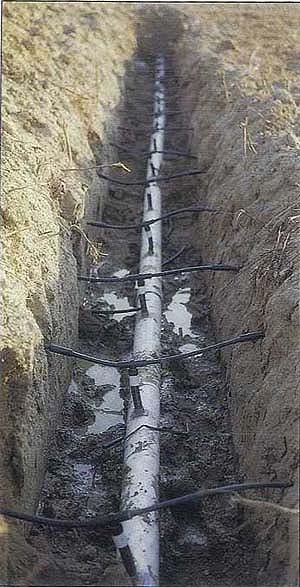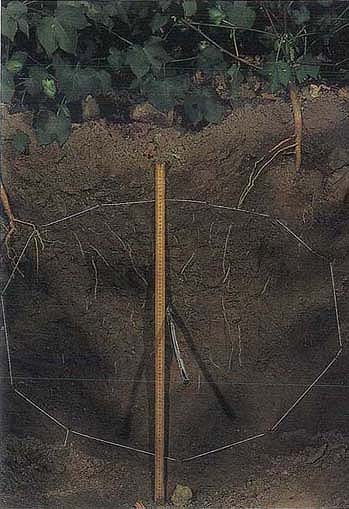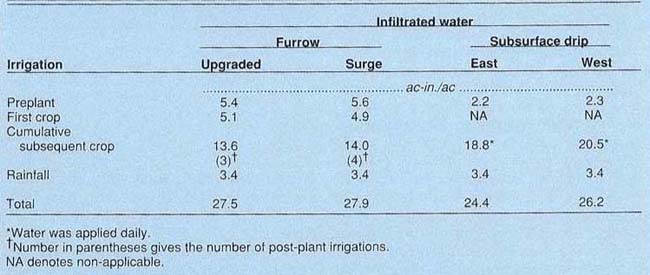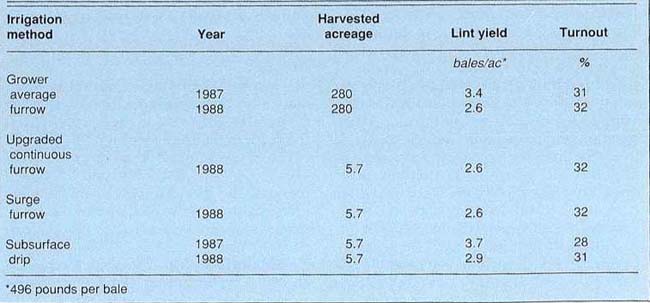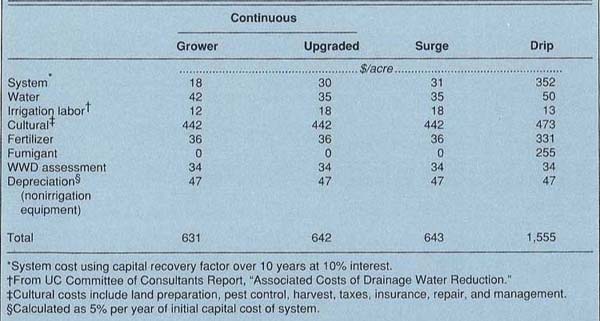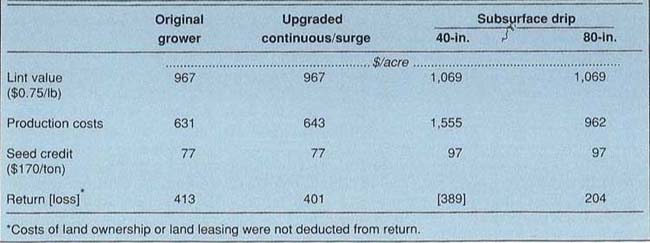All Issues
Reducing drainwater: Furrow vs. subsurface drip irrigation
Publication Information
California Agriculture 45(2):4-8.
Published March 01, 1991
PDF | Citation | Permissions
Abstract
Cotton was produced using conventional furrow irrigation, an upgraded continuous-flow furrow design, surge irrigation, and subsurface drlp lrrlgatlon in 1987 and 1988. We found that the most economical method of reducing potential drainage at this site was to reduce the furrow length by half and decrease the set time by more than one-half during preirrigation. A subsurface drip system reduced potential drainage most effectively and increased production, but caused an overall profit loss. Subsurface drip systems may be profitable if properly designed and managed; however, a substantial yield increase or reduction in drainage disposal costs must be achieved. Otherwise, profitability of subsurface drip would be less than that for furrow irrigation systems.
Full text
Southern San Joaquin Valley growers must often apply excess water to alleviate soil salinity or to compensate for nonuniform infiltration. This practice contributes to the expansion of the high water table. Meanwhile, annual salt importation with irrigation water amounts to 3 million tons. Soils also contain minor elements such as selenium, arsenic, molybdenum, uranium, vanadium, and boron that increase the environmental hazards of drainage disposal.
Disposal options — such as reuse of saline drainwater, discharge into underlying geologic strata or evaporation ponds, or proposed discharge into the ocean — are either expensive or controversial due to possible adverse effects on crop production and the environment. Whatever combinations of disposal options are ultimately selected, judicious use of irrigation water is a logical first step to minimize drainage volumes requiring disposal.
In 1986, the San Joaquin Valley Salinity and Drainage Workgroup (farmers, farm advisors, consultants, irrigation district and state agency staffs, and university and federal government researchers) concluded that there was a need for on-farm demonstrations of irrigation methods that had the potential of reducing drainage volumes. Several demonstrations are currently underway using funds and equipment provided by the University of California Salinity and Drainage Task Force, the U.S. Department of Agriculture's Agricultural Research Service (USDA-ARS), the California Department of Water Resources (DWR), the State Water Resources Control Board, irrigation industries, and farm cooperators. This paper, and the one following, report results obtained from two of these projects, which involve both furrow and pressurized irrigation systems.
Methods
Field site
The field data reported here were obtained from a 320-acre site located 10 miles southwest of Stratford, California. Continuous furrow, surge furrow, and subsurface drip irrigation systems were used to irrigate cotton on side-by-side 10-acre plots. The existing furrow system consisted of 40-inch beds and 2,500-foot furrow lengths with 0.16 % slope. The soil was a Westhaven clay loam; irrigation water was from the California Aqueduct. Soil salinity averaged 1.5 decisiemens per meter (dS/m) near the surface and increased to about 11 dS/m at a depth of 6 feet. The water table depth, which ranged from 5 to 9 feet, was nearer the surface on the east half of the field.
Continous furrow irrigation
In 1987, inflow and outflow were measured with broadcrested weir flumes installed in replicated sets of furrows to evaluate the amount of water infiltrated during the preirrigation and the first and last crop irrigations. The “two-point” volume balance method was used to develop an equation describing cumulative infiltration for each furrow. Data required for this method included field slope, wetted cross-sectional furrow area, water inflow and advance rates, and furrow length. Results from these evaluations were used to plan improvements of the conventional furrow irrigation system in 1988.
During preirrigation in 1988, furrow length was reduced from 2,500 feet to 1,250 feet by laying a second line of gated pipe 1,250 feet from the head ditch. Irrigation set times were reduced from 24 to about 11 hours and inflow rates were 36 gallons per minute (gpm). The furrow length was converted back to 2,500 feet for the crop irrigations and the inflow rate was increased to 43 gpm. Set times for the crop irrigations were 12 hours. The first crop irrigation and subsequent crop irrigations were scheduled at -16 bars and -18 bars leaf water potential, respectively, using the pressure chamber.
Surge irrigation
In 1987, surge irrigation was used during the crop irrigations in June, July, and August. Inflow and outflow were measured for replicate sets of furrows to determine the amount of infiltrated water for each irrigation. The resulting data were used to develop a management plan for 1988.
Four-inch sub-mainline is shown in a trench which runs across the furrows. Lines of drip tubing which have been shanked under the center of each 40-inch cotton bed are connected to the sub-mains before burying the line.
In 1988, furrow lengths were also reduced to 1,250 feet during preirrigation. Four surge cycles (40-gpm onflow rate) were used to pulse the water to the furrow ends: average cycle times were 50, 87, 94, and 128 minutes to advance water to 310, 620, 930, and 1,250 feet, respectively. The average cutback phase (20 gpm) was slightly under 10 hours.
Furrow length was converted to 2,500 feet for the crop irrigations. Six surge cycles (40 gpm) were used to advance water across the field: cycle times were 44, 73, 104, 147, 171, and 135 minutes to advance water to 420, 840, 1, 260, 1,680, 2,100, and 2,500 feet, respectively. The duration of the cutback phase (20 gpm) was about 9 hours. The crop irrigations were scheduled using the pressure chamber.
Subsurface drip
The operation pad included a water holding tank with inflow from the district valve controlled by an automatic float valve, a 35 horsepower electrical pump, two sand media filters with a backflush line, a fertilizer injection pump, a water meter, and an electronic controller. A 6-inch-diameter polyvinylchloride (PVC) mainline extended 1,800 feet downfield and was buried at a depth of 36 inches. Four-inch PVC submains were connected 615 feet down the main line and at its end. The submains were buried at 30 inches, perpendicular to the beds. Drip tubing (0.6-inch inside diameter) was shanked into the soil about 15 inches below the bottoms of alternate furrows (80-inch spacing between lines) and connected to the submains. The drip tubing extended 615 feet off both sides of the submains and was connected into 2-inch-diameter PVC drainlines with manual flushing valves. The pressure-compensated ram emittors in the drip tubing were spaced 39.3 inches apart and discharged water at the rate of 1 gallon per hour.
The cotton crop is shown above exposed drip tubing. Circled area shows type of root distribution found when cotton is grown with drip system.
Furrow irrigation was used to preirrigate in 1987 because of the wide drip-tube spacing. Irrigations were applied daily with the drip system beginning in May and ending September 15. Daily application rates were calculated from real-time estimates of grass reference evapotranspiration (ETo) and crop coefficients (Kc) for SJ-2 cotton developed by the USDA-ARS Water Management Research Laboratory, Fresno. The entire plot was irrigated at the same time.
Prior to the 1988 season, additional drip tubing was installed under the unused furrow to achieve 40-inch spacing between drip lines. The cotton beds were moved so that the tubing was located beneath the bed. An electric flow valve was installed at the inlet into each 4-inch submain to divide the system into two 5-acre parcels with flexibility for separate operation. The 40-inch tube spacing along with rainfall allowed adequate preirrigation. The irrigation scheduling method was the same as that used in 1987 except irrigation was cut off on August 30.
Management of other cultural practices
Land preparation, pest control, defoliation, and harvest were managed by the cooperator in all plots. Rates of fertilizers were managed by the cooperator in the furrow systems. Fertilizer and soil fumigant were applied through the subsurface drip system at rates based upon results from subsurface drip research in cotton monoculture at the Westside Field Station.
Nitrogen, phosporus, and zinc fertilizers were applied in the furrow-irrigated treatments at rates of 113, 40, and 5 pounds per acre, respectively, in 1987 and at rates of 129, 40, and 5 pounds per acre, respectively, in 1988. In the subsurface drip treatment, nitrogen, phosphorus, and potassium were applied at rates of 220, 63, and 63 pounds per acre, respectively, in 1987, and at rates of 176, 253, and 176 pounds per acre, respectively, in 1988. Zinc fertilizer was not applied in the subsurface drip plot in either year. Vapam soil fumigant was applied each seasonduring preirrigation at 30 gallons per acre to prevent root intrusion and control verticillum wilt and at 5 gallons per acre to assist defoliation.
Results and discussion
Water infiltrated predominantly through cracks in the fine-textured soil during the initial stage of infiltration. The initial water intake rate was very high, but declined to a much slower, steady rate after only 3 hours of infiltration. The steady state infiltration rate (table 1) was highest during preirrigation; by the last irrigation the rate was about eight times lower. As a result, the preirrigation and the first crop furrow irrigation were targeted for improved irrigation to reduce the amount of infiltrated water in the 1988 season.
The depth of water infiltrated during 1988 (table 2) preirrigation and first crop irrigation with the upgraded continuous-flow furrow system decreased by 2.3 and 1.8 acre-inches per acre, respectively, when compared to the infiltrated depths applied with the original furrow system in 1987 (table 1). Similarly, corresponding reductions for surge were 2.1 and 2.0 acre-inches per acre.
We recognize that climatic conditions which affect crop evapotranspiration (ETc), thereby affecting drainage, were not identical between the preirrigation and the first crop irrigation in 1987 and 1988. However, we believe the reductions in infiltrated water and potential for drainage in 1988 can be compared to the infiltrated amounts in 1987 for the following reasons: 1) the infiltration rates and potential for drainage were highest for preplant and first crop irrigations and 2) cumulative ETc prior to the first crop furrow irrigations was 3.58 and 3.24 inches in 1987 and 1988. respectively.
TABLE 1: Description of system performance for the conventional one-half mile furrow irrigation method in 1987
TABLE 2: Depth of infiltrated water with the upgraded continuous flow furrow, surge How furrow, and subsurface subsurface drip systems in 1988
TABLE 3: Machine-harvested cotton yields for upgraded continuous flow, surge, subsurface drip, and conventional irrigation by grower
Preirrigation with the drip system and rainfall provided adequate water for cotton germination and seedling establishment in 1988. The amount infiltrated, 2.2 to 2.3 acre-inches per acre, indicates potential to achieve additional drainage reduction with an irrigation system that provides sufficient control so that the applied water approximately equals the water depletion.
Crop yields in 1987 were uniformly higher than 1988, irrespective of the irrigation system (table 3). This reflects more favorable climatic conditions in 1987. Production for both the furrow and subsurface drip systems was not reduced when infiltrated water during preirrigation and the first crop irrigation were decreased. Crop yields for the upgraded continuous and surge flow were equal to the grower average.
In 1988, lint yields were 0.3 bale per acre higher for subsurface drip. More timely water application due to daily irrigation, a possible response to higher fertilizer rates, or more uniform water applications across the field were all factors that could have caused the increased production. A similar increase occurred in 1987. The lower gin turnout (table 3) in 1987 likely reflects poor defoliation due to the late irrigation cutoff date of September 15. In 1988, the gin turnout for subsurface drip was similar to the other treatments, which we attribute to the earlier irrigation cutoff date of August 30 and improved defoliation.
Irrigation system costs
In 1988, production costs excluding land (table 4) totalled $631, $642, and $643 per acre for the original grower furrow design, upgraded furrow design, and surge furrow system, respectively. We used gated pipe rather than siphon tubes to reduce furrow length, increasing system costs about $12 per acre. Shorter irrigation set times increased labor costs $6 per acre. Water savings reduced costs about $7 per acre.
The annualized costs of the system, fertilizer and fumigant were the primary factors that inflated the total production costs for the subsurface drip system to $1,555 per acre. The applicability of the fertilizer and fumigant costs for the subsurface drip to a larger farm scale are questionable. The fertilizer costs were high, in part due to the small quantity purchased and the premixed formulation. Based on individual prices for liquid sources of nitrogen, phosphorus, and potassium, the same amount of nutrients could have been purchased for about $87 and $160 per acre in 1987 and 1988, respectively.
Phosphorus fertilizer rates in 1988 may have been reduced. However, it is possible that phosphorus may be less available to plants irrigated by subsurface drip systems, which promotes root growth in less fertile subsoils. Fumigant is not needed for disease control if cotton is grown in rotation with other crops. Other economical alternatives — such as injections of acids, chloride, and use of emitters that are made of materials pretreated with herbicides — may control root intrusion. Eliminating ripping and reducing herbicide use saved $69 per acre but taxes, maintenance and repairs increased the total cultural costs $31 per acre. Pressurization added $15 per acre to the cost of water.
Profitability
In the assessment of profitability, we added an alternative subsurface drip irrigation system based on the 80-inch spacing used in 1987 and revised fertilizer and fumigant costs.
Returns were $12 per acre less for the upgraded continuous-flow furrow system compared to the original grower furrow system (table 5). On the cracking soils at this site, there was no economic benefit from water savings by using surge irrigation over the upgraded continuous-flow furrow system. At this location, where rising water tables and increased soil salinity are expected in the future, costs to improve the conventional furrow system and increase control of drainage would be less than costs associated with disposal of the additional drainwater generated from the conventional furrow system.
TABLE 4: Total annual costs for subsurface drip, surge, and the upgraded continuous flow furrow systems
TABLE 5: Profitability of the original grower furrow system, upgraded continuous flow or surge furrow systems, and subsurface drip in 1988
The increased system costs and increased fertilizer and fumigant costs resulted in a substantial loss of $389 per acre for the 40-inch drip system. Using 80-inch tube spacing would reduce the annual system costs to $200 per acre with a further reduction to $170 per acre being possible if less expensive, in-line emitters were used as was done at the DWR site described in the next paper. The corresponding costs for taxes, insurance, and maintenance would be reduced $53 per acre. Reduction or elimination of fumigation and use of higher analysis fertilizer materials would lower the total annual production costs about $250 per acre.
To assure drainage water control and adequate seed bed water content, an alternative method of preirrigation, such as hand-move sprinklers, would be required with the 80-inch system to achieve the same level of drainage reduction as with the 40-inch drip system. Preirrigation with a furrow system would not reduce potential drainwater as much due to the high water infiltration rates. Ultimately, the estimated annual production costs could be reduced to $965 per acre, excluding land costs.
Assuming similar yields could be achieved with an 80-inch subsurface drip system, as is indicated with the 1987 production results (table 3), a modified subsurface drip system could potentially generate a profit of approximately $204 per acre (table 5). This is about $200 per acre less return to land and management than achieved during a single year of cotton production with a well-designed and managed furrow irrigation system at this site. Either a direct and sizeable cost for disposal of added drainwater generated from the furrow systems, substantially higher yields, or changes in crop rotations to higher-value crops may increase the economic viability of subsurface drip at this site.
Future on-farm demonstration needs
Additional commercial demonstrations are now underway within drainage problem areas, supported by the DWR, the USDA-ARS, Cooperative Extension, and the U.S. Soil Conservation Service. Future needs to be addressed include: overcoming inconvenient set times for furrow systems with shortened furrow lengths; developing drainage reduction methods for surge flow irrigation of sandier soils; determining fertilization and chemigation requirements of subsurface drip irrigation; learning the nominal lifespan of subsurface drip systems; managing salinity with subsurface drip systems, particularly where water tables are shallower than those encountered in this field project, and optimizing subsurface drip system design (spacing and depth) for use with alternative crop rotations.



